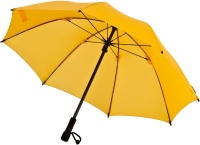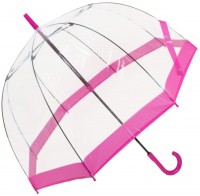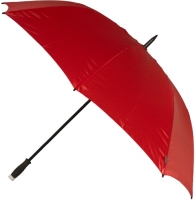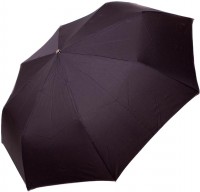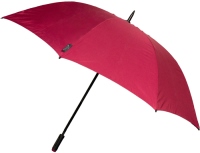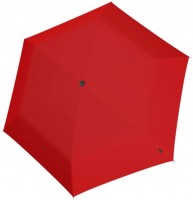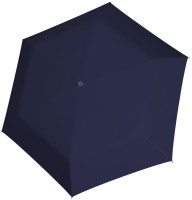Umbrellas Doppler
All Umbrellas Advanced filters → |
You might be interested in
Umbrellas: specifications, types
Type
The folding features and dimensions of the umbrella primarily depend on the type.
— Cane. The classic variety of umbrellas, historically the first to appear. Its main distinguishing feature can be called an awkward central rod, which usually has a rather large length; due to its size, many umbrellas of this type can also be used as an additional support when folded (hence the name). In addition to the possibility of additional use (which, however, requires caution, because not all canes are strong enough), cane umbrellas have other advantages over folding ones. So, they are stronger and more reliable, and the dome shape provides better moisture repellency and reduces the drying time of the fabric. The main disadvantage of such models can be called large dimensions when folded — the umbrella will not even fit in every suitcase, not to mention smaller bags. Therefore, this type is more of an "urban" than a "road" option.
— Foldable. Such umbrellas can have different designs, but all of them are distinguished by a folding central stem with several telescopic sections (see below). The main advantage of this type over canes is obvious: folding models are much more compact and easier to transport, and some of them are “packed” so tightly that they can even fit in a small handbag. On the other hand, the design of such products is more complicated, which increases...the price and reduces reliability; in addition, they are more likely to absorb moisture (if the material of the dome allows it, see below) and dry longer.
— Cane. The classic variety of umbrellas, historically the first to appear. Its main distinguishing feature can be called an awkward central rod, which usually has a rather large length; due to its size, many umbrellas of this type can also be used as an additional support when folded (hence the name). In addition to the possibility of additional use (which, however, requires caution, because not all canes are strong enough), cane umbrellas have other advantages over folding ones. So, they are stronger and more reliable, and the dome shape provides better moisture repellency and reduces the drying time of the fabric. The main disadvantage of such models can be called large dimensions when folded — the umbrella will not even fit in every suitcase, not to mention smaller bags. Therefore, this type is more of an "urban" than a "road" option.
— Foldable. Such umbrellas can have different designs, but all of them are distinguished by a folding central stem with several telescopic sections (see below). The main advantage of this type over canes is obvious: folding models are much more compact and easier to transport, and some of them are “packed” so tightly that they can even fit in a small handbag. On the other hand, the design of such products is more complicated, which increases...the price and reduces reliability; in addition, they are more likely to absorb moisture (if the material of the dome allows it, see below) and dry longer.
Suitable for
The purpose determines the category of people for which the umbrella is designed.
— Male. Traditional men's umbrellas have a strict, discreet design, which usually goes well with a business style.
— Female. Umbrellas specially designed for women are usually designed to match, often with unusual colours, patterns, and the like.
— Children's. Children's umbrellas are distinguished primarily by their characteristic bright design with variegated colours; they can also carry drawings — for example, with popular cartoon or comic book characters. Also, many of these models are smaller than "adults" — otherwise it would be inconvenient for a child to use an umbrella.
— Unisex. Umbrellas without a pronounced "gender", equally well suited for both men and women. They can have a different design — from restrained to quite bright and catchy.
— Male. Traditional men's umbrellas have a strict, discreet design, which usually goes well with a business style.
— Female. Umbrellas specially designed for women are usually designed to match, often with unusual colours, patterns, and the like.
— Children's. Children's umbrellas are distinguished primarily by their characteristic bright design with variegated colours; they can also carry drawings — for example, with popular cartoon or comic book characters. Also, many of these models are smaller than "adults" — otherwise it would be inconvenient for a child to use an umbrella.
— Unisex. Umbrellas without a pronounced "gender", equally well suited for both men and women. They can have a different design — from restrained to quite bright and catchy.
Anti-storm
The presence in the design of the umbrella of reinforced elements and additional parts that provide protection from strong winds. Note that the essence of such protection is not so much the prevention of eversion, but the ability to withstand bad weather without breaking. In other words, most storm umbrellas can easily turn inside out, but they endure this trouble without any consequences and easily return to normal working shape. And the wind directed from the outside, they resist much better than ordinary ones. Therefore, if you often have to be outside during heavy rains with strong winds, it makes sense to pay attention to models with this function.
Reverse folding
The reverse folding mechanism involves the use of both the inner and outer parts of the "cap" of the umbrella. When folded, the front part protrudes from the inside of the “cap”, but if the mechanism is expanded, the front part becomes the outer one, designed to protect against precipitation. Thus, when the umbrella is folded, the rain-soaked outer side is placed inside, so that the liquid accumulated on it will not splash around, but will drain into the base, from where it can be carefully poured at the first opportunity. Umbrellas with a reverse folding mechanism are more reliable and durable than traditional counterparts. If a strong gust of wind overtakes the user, then the umbrella with the reverse folding mechanism will not break from the inside out, but simply fold up, taking its second working position.
Mechanism
The procedure for unfolding and folding the umbrella depends primarily on the type of mechanism.
— Mechanical. The simplest option, which involves unfolding and folding solely due to the efforts of the user himself — in other words, you will have to manually move the slider along the central rod every time. Such a scheme of operation is not as convenient as automated options, however, it provides simplicity and reliability of the design, and it is cheaper.
— Semi -automatic. The name of this option is due to the fact that only one of the two actions is automated in it — disclosure; you have to fold the umbrella manually. Usually, to open, it is enough to press a button — and a special spring will bring the product into working position. Such umbrellas are easier and more convenient to use than mechanical ones — in particular, they open somewhat faster, which is especially important when exposed to heavy rain; at the same time, they are cheaper and more reliable than full automatic machines (although they still lose to them in terms of convenience).
— Automatic. In such models, both basic actions are automated: at the touch of a button, both the unfolding and folding of the umbrella occur. However it is worth noting that folding is most often not fully automated — usually the frame is only folded, and the telescopic rod has to be “squeezed” manual...ly. However, this is the most user-friendly option, requiring the least amount of effort from the user. The downside of such a mechanism is its complexity, high cost, and less reliability than others.
— Mechanical. The simplest option, which involves unfolding and folding solely due to the efforts of the user himself — in other words, you will have to manually move the slider along the central rod every time. Such a scheme of operation is not as convenient as automated options, however, it provides simplicity and reliability of the design, and it is cheaper.
— Semi -automatic. The name of this option is due to the fact that only one of the two actions is automated in it — disclosure; you have to fold the umbrella manually. Usually, to open, it is enough to press a button — and a special spring will bring the product into working position. Such umbrellas are easier and more convenient to use than mechanical ones — in particular, they open somewhat faster, which is especially important when exposed to heavy rain; at the same time, they are cheaper and more reliable than full automatic machines (although they still lose to them in terms of convenience).
— Automatic. In such models, both basic actions are automated: at the touch of a button, both the unfolding and folding of the umbrella occur. However it is worth noting that folding is most often not fully automated — usually the frame is only folded, and the telescopic rod has to be “squeezed” manual...ly. However, this is the most user-friendly option, requiring the least amount of effort from the user. The downside of such a mechanism is its complexity, high cost, and less reliability than others.
Frame material
The material from which the umbrella frame is made. The frame in this case means mainly the central rod, however, the spokes are often made of the same material — unless otherwise indicated in the characteristics (see "Spoke material").
— Steel. One of the most popular options among modern umbrellas. Steel allows you to provide good indicators of strength and elasticity. It is worth noting that different types and grades of this material can be used in umbrellas, so the actual characteristics of a particular steel frame are directly related to the price category of the product. However, steel is used even in high-end premium models. Of its "global" shortcomings, one can only note a rather large weight.
— Aluminium. Aluminium alloys used in umbrellas are noticeably lighter than steel, but less durable. They can also have different characteristics, usually directly related to the price category of the respective model, however, in general, this material is considered less reliable, and therefore is found mainly in entry-level and mid-level umbrellas.
— Fiberglass. Material based on glass drawn into thin threads. It has little in common with ordinary window glass: it is highly durable, does not break, and bends well without damage. Actually, flexibility is one of the main advantages of fiberglass — it is this material that is often used in storm umbrellas(see above), because. such knitting needles easily endure repeated turning inside out and back.
— Fiberglass. A polymeric material combining the fiberglass described above with a plastic base. It costs much less than pure fiberglass, but loses to it in terms of performance, which is why it is found mainly in inexpensive models of umbrellas.
— CFRP. A composite material that combines fine carbon fiber fabric and a plastic base. Differs in extreme durability — some grades surpass even steel — at the same time it weighs very little; on the other hand, the cost of CFRP is quite high. As a result of all this, this material is used quite rarely in umbrellas, mainly among luxury products.
— Tree. Wood has a pleasant appearance, but is inferior to metal in strength. Therefore, it is used mainly as a design material in some cane umbrellas (see "Type") — and even then in such models only the central rod is usually made of wood, the rest of the parts are made of metal.
— Plastic. Pure plastic is poorly suited for the manufacture of frames for umbrellas: it is not strong enough and resistant to stress for this. Therefore, this option can only be found in the most inexpensive models, as well as in children's umbrellas (see "Purpose"), for which light weight and the absence of sharp edges are more important than high strength.
Note that some models can be equipped with combined frames: for example, the central rod is made of steel, and the spokes are made of fiberglass. This is usually indicated in the specifications.
— Steel. One of the most popular options among modern umbrellas. Steel allows you to provide good indicators of strength and elasticity. It is worth noting that different types and grades of this material can be used in umbrellas, so the actual characteristics of a particular steel frame are directly related to the price category of the product. However, steel is used even in high-end premium models. Of its "global" shortcomings, one can only note a rather large weight.
— Aluminium. Aluminium alloys used in umbrellas are noticeably lighter than steel, but less durable. They can also have different characteristics, usually directly related to the price category of the respective model, however, in general, this material is considered less reliable, and therefore is found mainly in entry-level and mid-level umbrellas.
— Fiberglass. Material based on glass drawn into thin threads. It has little in common with ordinary window glass: it is highly durable, does not break, and bends well without damage. Actually, flexibility is one of the main advantages of fiberglass — it is this material that is often used in storm umbrellas(see above), because. such knitting needles easily endure repeated turning inside out and back.
— Fiberglass. A polymeric material combining the fiberglass described above with a plastic base. It costs much less than pure fiberglass, but loses to it in terms of performance, which is why it is found mainly in inexpensive models of umbrellas.
— CFRP. A composite material that combines fine carbon fiber fabric and a plastic base. Differs in extreme durability — some grades surpass even steel — at the same time it weighs very little; on the other hand, the cost of CFRP is quite high. As a result of all this, this material is used quite rarely in umbrellas, mainly among luxury products.
— Tree. Wood has a pleasant appearance, but is inferior to metal in strength. Therefore, it is used mainly as a design material in some cane umbrellas (see "Type") — and even then in such models only the central rod is usually made of wood, the rest of the parts are made of metal.
— Plastic. Pure plastic is poorly suited for the manufacture of frames for umbrellas: it is not strong enough and resistant to stress for this. Therefore, this option can only be found in the most inexpensive models, as well as in children's umbrellas (see "Purpose"), for which light weight and the absence of sharp edges are more important than high strength.
Note that some models can be equipped with combined frames: for example, the central rod is made of steel, and the spokes are made of fiberglass. This is usually indicated in the specifications.
Spoke material
The material from which the spokes of the umbrella are made. It may differ from the frame material (see the relevant paragraph), which is why this parameter is given separately.
— Steel. One of the most common knitting needle materials. In modern umbrellas, different grades of steel can be used, differing in price and quality; usually, this moment directly depends on the price category of the umbrella. However, anyway, this material is strong enough, resilient, reliable and durable, and is relatively inexpensive. The main disadvantage of steel can be called a relatively large weight.
— Aluminium. Compared to steel, aluminium is distinguished, on the one hand, by its lower weight, and, on the other hand, by its relatively low strength. As a result, it is relatively rare, mainly in children's umbrellas and low-cost "adult" models.
— Fibreglass. A material based on a fibre of thin glass threads. Differs in rather high durability and reliability. However, the main advantage of this material can be called the ability to bend well without damage, which allows such knitting needles to normally endure turning the dome inside out. This is especially important for storm umbrellas(see above), although it will be useful for a regular umbrella. However, such knitting needles are more expensive than the same steel ones.
...>
— Fibreglass. Composite material made of glass fibre filled with plastic. It is similar in properties to the fibreglass described above, however, on the one hand, it is cheaper, on the other hand, it is somewhat inferior to it in terms of performance, including the same flexibility.
— CFRP. Composite carbon fibre material with plastic filler. With a small weight, carbon fibre is highly durable, however, it also costs accordingly, which is why it is relatively rare.
— Steel. One of the most common knitting needle materials. In modern umbrellas, different grades of steel can be used, differing in price and quality; usually, this moment directly depends on the price category of the umbrella. However, anyway, this material is strong enough, resilient, reliable and durable, and is relatively inexpensive. The main disadvantage of steel can be called a relatively large weight.
— Aluminium. Compared to steel, aluminium is distinguished, on the one hand, by its lower weight, and, on the other hand, by its relatively low strength. As a result, it is relatively rare, mainly in children's umbrellas and low-cost "adult" models.
— Fibreglass. A material based on a fibre of thin glass threads. Differs in rather high durability and reliability. However, the main advantage of this material can be called the ability to bend well without damage, which allows such knitting needles to normally endure turning the dome inside out. This is especially important for storm umbrellas(see above), although it will be useful for a regular umbrella. However, such knitting needles are more expensive than the same steel ones.
— CFRP. Composite carbon fibre material with plastic filler. With a small weight, carbon fibre is highly durable, however, it also costs accordingly, which is why it is relatively rare.
Number of spokes
The number of spokes provided in the umbrella frame. Theoretically, the more spokes, the stiffer and more reliable the frame. At the same time, the actual properties of the product are largely determined by other factors — the material of the spokes and the dome, their design features, the general type of umbrella (see above), etc. Therefore, we can say that in most cases the number of spokes is a purely reference parameter that does not have a noticeable effect on performance.
Dome diameter
The diameter of the umbrella dome when unfolded. The larger the diameter of the dome, the more reliably it will protect you from rain and the easier it will be to place one more person under the umbrella. On the other hand, a wide umbrella can be uncomfortable in tight spaces — for example, in the flow of pedestrians on a busy street — and when folded it will take up more space. Therefore, it does not always make sense to choose the largest of the available options.
The minimum diameter for an "adult" umbrella (see "Destination") is considered to be about 80 cm. Most models are in the range of 90 – 110 cm — this provides a good degree of protection with ease of movement. And in the largest modern products, the diameter of the dome can reach 150 cm.
The minimum diameter for an "adult" umbrella (see "Destination") is considered to be about 80 cm. Most models are in the range of 90 – 110 cm — this provides a good degree of protection with ease of movement. And in the largest modern products, the diameter of the dome can reach 150 cm.
Length (folded)
The length of the umbrella when folded. For the decomposed one, this parameter is not specified, because is not critical, but when transporting a closed umbrella, it is the length that is the most important dimension.
The length of cane umbrellas (see "Type") is, by definition, the same when open or closed; most often it is 60 – 90% of the dome diameter (see above). But folding models of the same diameter can vary markedly in length, and here the choice depends on the situation: on the one hand, more compact umbrellas are more convenient to carry, on the other hand, they are less reliable and more complex in design, and also cost more.
The length of cane umbrellas (see "Type") is, by definition, the same when open or closed; most often it is 60 – 90% of the dome diameter (see above). But folding models of the same diameter can vary markedly in length, and here the choice depends on the situation: on the one hand, more compact umbrellas are more convenient to carry, on the other hand, they are less reliable and more complex in design, and also cost more.
Emerging pattern
The outer side of the umbrella with a developing pattern can change its colour under the influence of moisture. That is, when wet in the rain, the fabric acquires a new colour, most often bright and colorful. When the umbrella dries, the original shade returns. The colour of the umbrella can be changed both completely and element by element — it all depends on the design of the particular model. The technology of the developing pattern is based on a hydrochromic dye, which reacts with water molecules, thereby changing its shade.
Dome material
The material of the dome is a canopy stretched between the spokes of the umbrella.
— Polyester. Synthetic material, the most popular among modern umbrellas. It has good strength and density, as well as water-repellent properties (although in its pure form it still gets wet sooner or later); in addition, it is resistant to temperature extremes and ultraviolet radiation. It is also worth noting that various additives can be used in polyester domes, which can significantly change the appearance and properties of the fabric — for example, it can easily be given a resemblance to silk or satin, provide additional water-repellent properties, etc. Therefore, we can say that such umbrellas are very diverse, and the properties of the dome largely depend on the price category of the product.
— Nylon. Synthetic material, somewhat similar to polyester, but cheaper — and in every sense: it is inexpensive, but it loses in a number of characteristics. In particular, nylon is not so strong and reliable, besides it is less pleasant to the touch, and after drying it can “sit down”. It is used mainly in low-cost models of umbrellas.
— Eponge. Cotton or silk fabric, characterized by an original surface texture — it resembles a sponge (hence the name — from the French eponge). However, unlike a regular sponge, pongee practically does not absorb moisture — on the contrary, it has excellent water-repellent properties and dries quickly. At the same time, the fabric has a...n original appearance, is pleasant to the touch, and its price is low, which makes it possible to use this material even in relatively inexpensive umbrellas.
— Silk. Silk provides the product with a luxurious appearance, but loses to other materials in terms of strength, and also gets very wet. As a result, this material is usually used in umbrellas from the sun (see "Application"), and among the "rain" is almost never found.
— PVC film. Distinctive features of a film based on polyvinyl chloride (PVC) are complete imperviousness, as well as transparency. This allows you to create on its basis not only classic umbrellas, but also the so-called birdcage ("birdcage") — models with a high dome, covering not only the head, but also the shoulders.
— Jacquard. Waterproof fabric, usually synthetic, having a so-called jacquard weave. Due to this, a specific texture pattern is visible on the surface of the dome, giving it an original appearance. On the other hand, jacquard is quite difficult to manufacture, and therefore expensive.
— Satin. Cotton or silk fabric with an additional water-repellent impregnation, having a satin weave. This weave gives a rather dense surface with a characteristic sheen, giving it a pleasant appearance. Satin is used mainly in design models of umbrellas, on the domes of which various patterns are applied.
— Polyamide. Polyamides is the general name for a number of synthetic fibers, in particular, capron and nylon (see above). They have good water-repellent properties, but the performance characteristics (durability, resistance to stretching, etc.) can be different — depending on the price category of the umbrella.
— Polyester. Synthetic material, the most popular among modern umbrellas. It has good strength and density, as well as water-repellent properties (although in its pure form it still gets wet sooner or later); in addition, it is resistant to temperature extremes and ultraviolet radiation. It is also worth noting that various additives can be used in polyester domes, which can significantly change the appearance and properties of the fabric — for example, it can easily be given a resemblance to silk or satin, provide additional water-repellent properties, etc. Therefore, we can say that such umbrellas are very diverse, and the properties of the dome largely depend on the price category of the product.
— Nylon. Synthetic material, somewhat similar to polyester, but cheaper — and in every sense: it is inexpensive, but it loses in a number of characteristics. In particular, nylon is not so strong and reliable, besides it is less pleasant to the touch, and after drying it can “sit down”. It is used mainly in low-cost models of umbrellas.
— Eponge. Cotton or silk fabric, characterized by an original surface texture — it resembles a sponge (hence the name — from the French eponge). However, unlike a regular sponge, pongee practically does not absorb moisture — on the contrary, it has excellent water-repellent properties and dries quickly. At the same time, the fabric has a...n original appearance, is pleasant to the touch, and its price is low, which makes it possible to use this material even in relatively inexpensive umbrellas.
— Silk. Silk provides the product with a luxurious appearance, but loses to other materials in terms of strength, and also gets very wet. As a result, this material is usually used in umbrellas from the sun (see "Application"), and among the "rain" is almost never found.
— PVC film. Distinctive features of a film based on polyvinyl chloride (PVC) are complete imperviousness, as well as transparency. This allows you to create on its basis not only classic umbrellas, but also the so-called birdcage ("birdcage") — models with a high dome, covering not only the head, but also the shoulders.
— Jacquard. Waterproof fabric, usually synthetic, having a so-called jacquard weave. Due to this, a specific texture pattern is visible on the surface of the dome, giving it an original appearance. On the other hand, jacquard is quite difficult to manufacture, and therefore expensive.
— Satin. Cotton or silk fabric with an additional water-repellent impregnation, having a satin weave. This weave gives a rather dense surface with a characteristic sheen, giving it a pleasant appearance. Satin is used mainly in design models of umbrellas, on the domes of which various patterns are applied.
— Polyamide. Polyamides is the general name for a number of synthetic fibers, in particular, capron and nylon (see above). They have good water-repellent properties, but the performance characteristics (durability, resistance to stretching, etc.) can be different — depending on the price category of the umbrella.
Handle material
— Plastic. As a material for umbrella handles, plastic is very practical: it has a low price, is resistant to moisture, and its strength, although lower than that of metals, is quite sufficient in this case, especially since there are many varieties of this material on the market, including number and are very durable. It is also worth noting the low thermal conductivity of plastic — it does not "cool" the hand in cool weather. Similar handles are used in umbrellas of all price categories.
— Tree. Wood, like plastic, does not conduct heat well and does not cool the hand, while many consider it more pleasant to the touch; Yes, and this material looks quite stylish. At the same time, wooden handles are somewhat more expensive, and their quality noticeably depends on the price category of the umbrella (although in a cheap product, the frame is more likely to break than the handle).
— Skin. In this case, of course, we are talking about a handle made of hard material (usually wood or plastic, see above), covered with genuine leather. Such a coating gives the pen a rich and solid appearance and well emphasizes the image of the owner — after all, leather is quite expensive. Of the practical disadvantages of this option, it is worth noting the exactingness of care — otherwise the material may lose its presentation.
— Metal....Metal handles are usually an integral extension of the central rod. They are very durable, besides they look stylish, but they tend to "cool" the hand and slip out of it — therefore they are rarely used, mainly in designer models.
— EVA foam. Handles in the form of a solid base (usually the same material as the frame), covered with a layer of ethylene vinyl acetate (EVA) foam. This coating is pleasant to the touch, does not slip in the hand and provides a secure hold. At the same time, for a number of reasons, this option is found mainly in premium models.
— Tree. Wood, like plastic, does not conduct heat well and does not cool the hand, while many consider it more pleasant to the touch; Yes, and this material looks quite stylish. At the same time, wooden handles are somewhat more expensive, and their quality noticeably depends on the price category of the umbrella (although in a cheap product, the frame is more likely to break than the handle).
— Skin. In this case, of course, we are talking about a handle made of hard material (usually wood or plastic, see above), covered with genuine leather. Such a coating gives the pen a rich and solid appearance and well emphasizes the image of the owner — after all, leather is quite expensive. Of the practical disadvantages of this option, it is worth noting the exactingness of care — otherwise the material may lose its presentation.
— Metal....Metal handles are usually an integral extension of the central rod. They are very durable, besides they look stylish, but they tend to "cool" the hand and slip out of it — therefore they are rarely used, mainly in designer models.
— EVA foam. Handles in the form of a solid base (usually the same material as the frame), covered with a layer of ethylene vinyl acetate (EVA) foam. This coating is pleasant to the touch, does not slip in the hand and provides a secure hold. At the same time, for a number of reasons, this option is found mainly in premium models.
Handle shape
— Hook. The characteristic curved handle allows you to hang the umbrella on any suitable device - the back of a chair, a clothes hanger, etc. In addition, it is quite secure when held and provides a stylish appearance with a hint of traditional classics. On the other hand, a hook makes the entire product more bulky and inconvenient to transport - therefore, it is found mainly among canes (see “Type”), where the main inconvenience is due to the size of the umbrella itself and depends little on the shape of the handle. Also, some believe that “hooks” are more likely to get lost than models with other types of handles; and this opinion is not without foundation - for example, there is a high probability of forgetting about such an umbrella hung by the handle in an inconspicuous place.
- Direct. An elongated handle of a cylindrical (or close to it) shape; in some models it may be slightly bent - for example, to imitate the knob of a cane. Very comfortable to hold, but not as secure as a hook and less compact than a round one.
- Round. This category includes handles that are close in shape to either a ball or a very short cylinder (the height of which is comparable to the diameter). This option is the most compact and is considered optimal for folding umbrellas(see “Type”), created with ease of portability in mind. On the o...ther hand, in terms of reliability and ease of holding, round handles are inferior to the types described above; This is partly compensated for by the wrist strap provided in many similar models.
- C-shaped. A rather unusual type of handle is in the form of a loop with a small slot resembling the letter C. The slot is provided so that the umbrella can be hung on a rope or other similar device. In any case, this form provides two advantages over more traditional options. Firstly, it provides more grip options - you can grab the bottom of the loop, the side, between them, etc. Secondly, it allows you to free your hands when holding an open umbrella: the C-shaped handle can be put on the wrist, and The central rod should be rested on the shoulder; as a result, the hand will be free. On the other hand, this type of handle is quite bulky and expensive; It is because of this that they have not gained much popularity.
- Direct. An elongated handle of a cylindrical (or close to it) shape; in some models it may be slightly bent - for example, to imitate the knob of a cane. Very comfortable to hold, but not as secure as a hook and less compact than a round one.
- Round. This category includes handles that are close in shape to either a ball or a very short cylinder (the height of which is comparable to the diameter). This option is the most compact and is considered optimal for folding umbrellas(see “Type”), created with ease of portability in mind. On the o...ther hand, in terms of reliability and ease of holding, round handles are inferior to the types described above; This is partly compensated for by the wrist strap provided in many similar models.
- C-shaped. A rather unusual type of handle is in the form of a loop with a small slot resembling the letter C. The slot is provided so that the umbrella can be hung on a rope or other similar device. In any case, this form provides two advantages over more traditional options. Firstly, it provides more grip options - you can grab the bottom of the loop, the side, between them, etc. Secondly, it allows you to free your hands when holding an open umbrella: the C-shaped handle can be put on the wrist, and The central rod should be rested on the shoulder; as a result, the hand will be free. On the other hand, this type of handle is quite bulky and expensive; It is because of this that they have not gained much popularity.
Clasp
The type of clasp installed on the umbrella strap.
We are talking about a strap that tightly secures the dome in the closed position. Most often, Velcro or a button is used as a fastener, and in some models a button is used. Here is a description of each option:
- Velcro. The most popular type of fastener these days. Velcro is inexpensive, extremely compact (in particular, it does not protrude above the strap, unlike buttons), and is also easy to use - so they can be found in all price categories of umbrellas. The main disadvantage of such devices is that as they wear out, their effectiveness drops noticeably - to the point that at one point the Velcro stops holding it at all. However, the service life of such fasteners is still usually quite long, and worn-out Velcro can be replaced without any problems or costs in a workshop or even on your own.
- Button. The clasp is in the form of a characteristic metal button, like clothing buttons. Such devices are much more reliable and durable than Velcro, but they are more expensive and somewhat less convenient: unfastening the button requires a certain amount of force, and fastening it also requires greater precision. In addition, not all users like the part that noticeably protrudes from the strap when the umbrella is closed. In light of this, buttons are used much less often than Velcro, and mainly in models of the middle and to...p price categories (with rare exceptions).
- Button. An ordinary button that, when fastened, is threaded into a loop. From a practical point of view, such fasteners are noticeably inferior to Velcro and buttons - they are not as reliable, and they are not particularly convenient. Therefore, buttons can be found extremely rarely in our time - in individual cane umbrellas in the “retro” style, where such a fastener is used primarily as a characteristic design element.
We are talking about a strap that tightly secures the dome in the closed position. Most often, Velcro or a button is used as a fastener, and in some models a button is used. Here is a description of each option:
- Velcro. The most popular type of fastener these days. Velcro is inexpensive, extremely compact (in particular, it does not protrude above the strap, unlike buttons), and is also easy to use - so they can be found in all price categories of umbrellas. The main disadvantage of such devices is that as they wear out, their effectiveness drops noticeably - to the point that at one point the Velcro stops holding it at all. However, the service life of such fasteners is still usually quite long, and worn-out Velcro can be replaced without any problems or costs in a workshop or even on your own.
- Button. The clasp is in the form of a characteristic metal button, like clothing buttons. Such devices are much more reliable and durable than Velcro, but they are more expensive and somewhat less convenient: unfastening the button requires a certain amount of force, and fastening it also requires greater precision. In addition, not all users like the part that noticeably protrudes from the strap when the umbrella is closed. In light of this, buttons are used much less often than Velcro, and mainly in models of the middle and to...p price categories (with rare exceptions).
- Button. An ordinary button that, when fastened, is threaded into a loop. From a practical point of view, such fasteners are noticeably inferior to Velcro and buttons - they are not as reliable, and they are not particularly convenient. Therefore, buttons can be found extremely rarely in our time - in individual cane umbrellas in the “retro” style, where such a fastener is used primarily as a characteristic design element.
Weight
Total weight of the umbrella.
All other things being equal, lighter umbrellas are more convenient to carry (both in the open and closed positions). On the other hand, such products are less reliable and/or more expensive than relatively heavy models of similar design and size. We also note that in some cases, significant weight can be an advantage. For example, in a strong wind, a massive umbrella does not “tear from your hands” as much, and when released, it does not fly as far as a lighter one.
All other things being equal, lighter umbrellas are more convenient to carry (both in the open and closed positions). On the other hand, such products are less reliable and/or more expensive than relatively heavy models of similar design and size. We also note that in some cases, significant weight can be an advantage. For example, in a strong wind, a massive umbrella does not “tear from your hands” as much, and when released, it does not fly as far as a lighter one.



